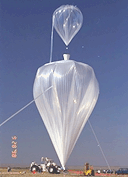
|
 |
|
Launch
Day:
Just as with the launching of any other launch vehicle, not only must the
equipment be declared ready to go, but the weather conditions must be suitable
as well.
 |
||
|
Figure 1. The flight of MSAM1, June 1994. |
Figure 2. MSAM/TopHat Test flight, September 1998, Ft. Sumner, Texas. |
Figure 3. The flight of MSAM2, June 1997. |
Lift off!
At launch the balloon appears under-inflated but as the balloon rises the gas expands because the atmosphere is thinner and therefore the pressure inside the balloon is greater than the atmospheric pressure. The balloon expands until it is completely full. Any excess Helium, used to get the balloon to float altitude, is vented through ducts on the bottom of the balloon. This type of balloon is referred to as a "zero pressure balloon" because the pressure of the Helium inside the balloon is the same as the atmospheric pressure outside. If there is not a zero pressure differential, the excess gas will be vented through the ducts until zero pressure is achieved.
Retrieving
the Payload:
After the scientist
has concluded the experiment, a radio command is sent from a ground station
to a radio receiver in the payload gondola. The radio receiver sends a signal
to fire the squib. The squib
cuts the cable holding the clamps which hold the parachute to the balloon. Since
the parachute is already stretched out, it opens by itself as the payload begins
to fall. At the bottom of the chute there is a separating mechanism to separate
the parachute from the payload when it hits the ground. If they did not separate
the parachute would keep dragging the payload across the ground and the payload
would be seriously damaged.
The balloon is designed to tear when it separates from the payload. This releases
the gas inside it. The balloon material then falls to the ground, where it
is retrieved and discarded.
SCIENCE | INSIDE BALLOONS | LAUNCH | GET INVOLVED | TOUR A BALLOON BASE | WHY A BALLOON? | GLOSSARY | GUESTBOOK |